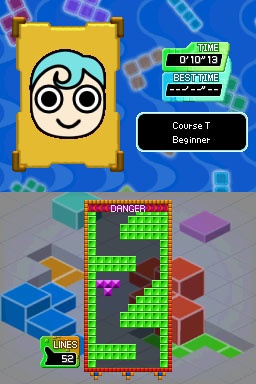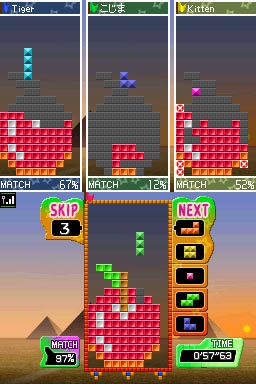Since its original release more than 20 years ago, Tetris has graced dozens of consoles with its ubiquitous block dropping. While each release puts a new spin on Alexey Pajitnov's classic, the best Tetris games remain faithful to the formula that was already nearly perfect at its inception. When Tetris Party launched on WiiWare almost two years ago, it kept these basics intact and introduced some interesting twists. On the DS, Tetris Party Deluxe fleshes out some of these ideas and is a fun version of Tetris in its own right.

In addition to the standard Marathon and Sprint modes, which involve clearing as many lines as quickly as you can, Tetris Party Deluxe offers a nice variety of new mechanics that slow down the traditionally frenetic pace. In Field Climber, the player creates footholds with the tetriminos (that is, the falling blocks) to allow a climber to ascend to the top of the screen. The little guy can only move up one block at a time, and there are checkpoints to reach on each level, so Field Climber requires a more methodical approach. Shadow mode, in which you must complete a puzzle that appears as a shadow in the background, is also more cerebral than most Tetris varieties. This mode uses shapes that are different from the traditional tetriminos and allows you to skip a limited number of blocks you can't find a place for, challenging you to use your Tetris skills in creative new ways.
If you'd rather stick with speed, there are a few new modes to accommodate you as well. In the returning Bombliss mode, bomb blocks destroy neighboring pieces, and bomb pieces destroy nearby tetriminos when cleared. In Master mode, the game is sped up so that blocks drop instantly, and you'll need lightning-fast reflexes to survive longer than a minute or two. While these modes remain largely faithful to the original Tetris mechanics, Stage Racer is an interesting departure. Instead of clearing lines, you'll navigate a single tetrimino through a course to the goal 400 lines below. The time it takes you to reach the goal is your score, making Stage Racer more of a racing game than a new style of Tetris. Trying to beat your own times is surprisingly addictive.
Each of these new modes can be played against up to eight human or AI opponents. The more traditional battle modes allow you to use power-up items during the match. For example, you can stop your opponent's tetriminos from rotating, shoot blocks onto his or her grid, or force him or her to use a single type of block for a limited period of time. These items are always fun to use and add an extra element of strategy to the otherwise straightforward tactic of clearing rows faster than your opponent. Local multiplayer also introduces Duel Spaces mode, where players take turns dropping blocks to compete for control over a larger area of the board. Although it would be more frantic if both players were allowed to drop blocks simultaneously, Duel Spaces is a fun alternative to the simple battle mode included in most Tetris games. The new Co-op Tetris does allow both players to drop blocks simultaneously on the same grid and is all the better for it. If you can't convince a buddy to pick up his own copy of the game, the conventional Versus Battle and Co-op Tetris are both available in single-card download play.
Because all of these multiplayer varieties make such great additions to competitive Tetris, it's a shame that online matches are so limited. Although you can use the aforementioned power-ups, the only options you have when playing online against friends or strangers are Duel Spaces and the basic multiplayer battle where you try to clear rows faster than your opponent. The online population is sparse, but at least you can play Tetris in practice mode while you wait in a lobby.

While it's true that the appeal of a game like Tetris relies heavily on core mechanics rather than style, it's unfortunate that more attention wasn't paid to presentation value in Tetris Party Deluxe. Each gameplay mode has a single music track and background image. You can choose which song and image you want to display, but that is the extent of the game's customization options. If you're a particularly skilled player, the repetition during extended sessions quickly becomes grating. There's nothing particularly offensive about the visual design here, but there's nothing inspired either. Perfunctory visuals and repetitive music are disappointing, regardless of the genre.
The best versions of Tetris remain true to the original formula while introducing enough new elements to warrant investing your time in yet another release of the franchise. Tetris Party Deluxe certainly offers a variety of innovations that keep the game feeling fresh and make this a worthy addition to the Tetris library on the DS. However, if you already own the previously released Tetris DS, the dearth of online modes and lackluster presentation values give little reason to purchase another version on the same handheld.